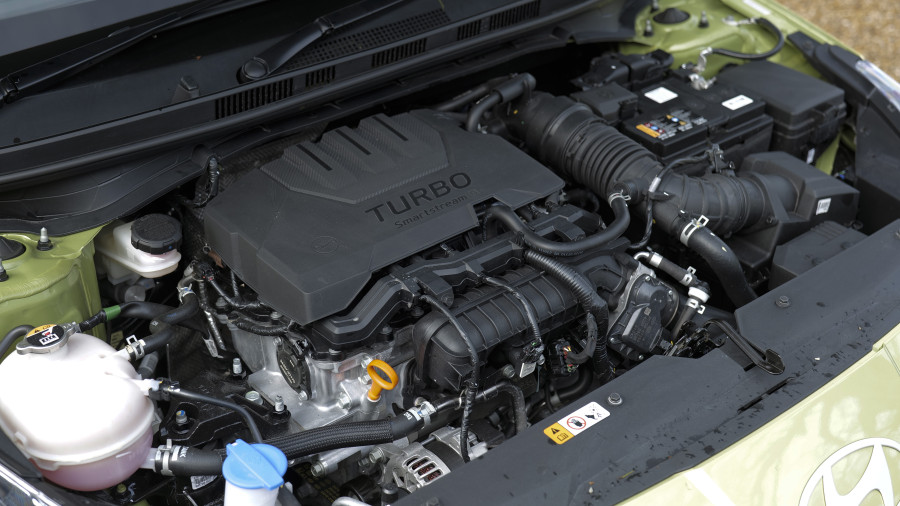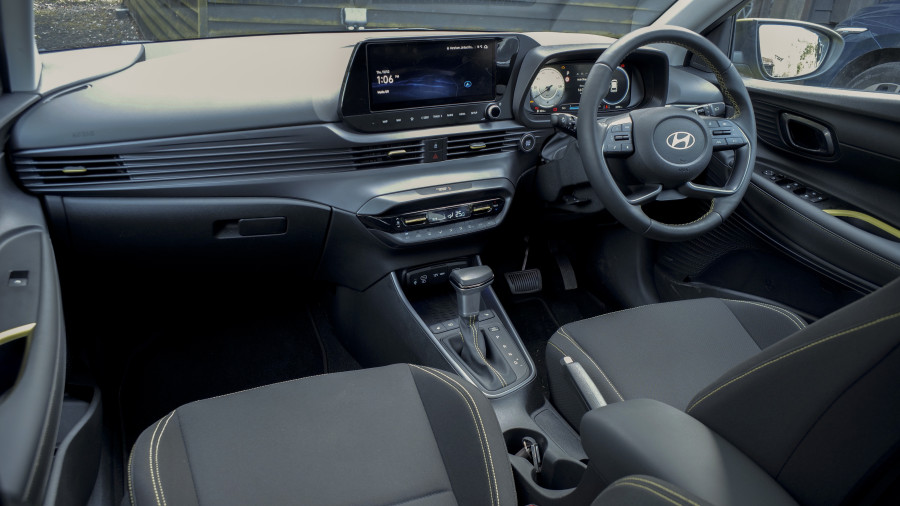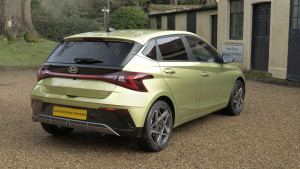The Hyundai i20 started slow but has built up genuine momentum. The revised version of this third generation version looks to keep that trajectory arrowing upwards. Jonathan Crouch drives it.
Ten Second Review
The third generation version of Hyundai's i20 has been usefully improved. No longer merely a budget choice, it now has the quality, the efficiency, the technology and the looks to square up against the supermini class leaders. Plus it's still got one of the best after-sales packages anywhere in the car industry - and pricing hasn't got too ambitious. In other words, if you're shopping in this segment, here's a car you shouldn't leave off your shortlist.
Background
We're used to hearing success stories from Hyundai, but in recent years, there's one important market segment this Korean company has found something of a struggle: that for superminis. The company's i20 model has always aimed to rectify that oversight, but the MK1 and MK2 versions (introduced respectively in 2009 and 2015) have had limited success in this regard. This third generation design was launched back in 2020 aiming to do better, aided by a much more eye-catching design and the introduction of a clever mild hybrid 1.0-litre T-GDi petrol powerplant.
Like its predecessors, this MK3 'BC3'-series design was developed following a German-based product development programme and a demanding testing schedule on roads right across the Euro zone. This one, in other words, was created precisely for us. And three years into its production cycle, it's been usefully improved to create the car we're going to look at here.
Driving Experience
Nothing much has changed beneath the bonnet with the revised version of this third generation i20. Various engines are being offered with this car in other markets but here, for mainstreams versions, we only get a single unit - a 1.0-litre T-GDi petrol powerplant putting out 100PS. It's a 48-volt mild hybrid powertrain, a system which harvests energy that would otherwise be wasted under deceleration and can redeploy that power to reduce load on the engine. This car is offered with either a 6-speed iMT manual gearbox or 7-speed 7DCT auto transmission. The 'iMT' manual 'box is interesting, featuring an electronic clutch able to decouple the gearbox from the engine when coasting to save fuel.
Across the range, the i20 has always made great play of being designed by Europeans, in Europe for European conditions, so it's no surprise that buyers of this model have always liked the way the car drives. With this MK3 version, the steering system is a brushless a/c electric motor-driven steering set-up that offers a really tight turning radius - which should make the car easy to navigate in town. Excellent forward visibility is enabled by the slim front A-pillars. Hyundai says that it's concentrated on keeping the steering light and direct, which should further help in an urban environment. This and the wheel-at-each-corner design makes each extremity of the car easy to position and it ought to be simplicity itself to park. Just as a supermini should be.
Design and Build
This third generation i20 supermini was the first of the Korean company's European models to feature its so-called 'Sensuous Sportiness' design language - and that's subtly evolved with this revised version. The shape and pattern of the front bumper and radiator grille have been restyled and the rear features another revised bumper and a unique Z-shaped LED tail lamp design. Plus there are freshly designed 16 and 17-inch wheels. As before, the wedgy side view of the single five-door body shape offers a bold side character line and an eye-catching C-pillar design.
Inside, this revised model feels a bit smarter than before thanks to the addition of multi-colour LED ambient lighting. As before, the interior has plenty of soft-touch textured plastics, a smart four-spoke steering wheel and a fascia design broken up by horizontal slates that run the width of the interior and blend into the air vents. As you'd expect, infotainment is well taken care of, all versions featuring a 10.25-inch centre-dash touchscreen with 'Apple CarPlay'/'Android Auto' smartphone-mirroring as standard-fit. As is a 10.25-inch instrument screen - still unusual in the segment.
When it comes to the rear seat, you'll find that the doors open nice and wide and once inside, you'll find that this Hyundai has as much rear space for legs and knees as you could reasonably expect in this class. Headroom isn't quite so noteworthy, thanks to the tapering rear roof line, but the relatively low centre transmission tunnel means it's a bit more realistic to take a trio of passengers back here if you absolutely had to.
Lift the hatch and you're greeted with one of the more accommodating luggage areas in the segment, 352-litres in size. One day, a supermini maker will offer the flexibility of either a ski hatch or a 40:20:40 seatback split, but that day hasn't yet come, so there's just a conventional 60:40split backrest that lowers to reveal a 1,165-litre total capacity.
Market and Model
There's a single five-door body style and pricing that reflects the mild hybrid tech, sitting in the £21,500 to £25,000 bracket for mainstream models. These figures underline the fact that Hyundai no longer feels the need to pitch its products against bargain brands. As for equipment levels across the range, well Hyundai isn't holding back. There are four trim levels - 'Advance', 'Premium', 'Ultimate' and 'N Line S'.
This revised model has been upgraded with a second-generation eCall system based on the 4G network, and Over-the-Air (OTA) map updates. It continues to offer features that were already popular in the previous version, such as the 10.25-inch instrument cluster and the central 10.25-inch display screen, which of course has Apple CarPlay and Android Auto and now features an update to its Bluelink telematics set-up.
Across the line-up, a whole range of Hyundai Smart Sense safety features now come as standard. There's Autonomous Emergency Braking; and 'Forward Collision-Avoidance Assist' which can also detect pedestrians and cyclists. And 'Lane Follow Assist', which works with the car's standard Cruise Control system and uses a camera to keep your i20 centred in lane, working between 0 and 81mph, alerting you if you drift over lane markings. As before, this Hyundai comes with 'Lane Departure Warning', complete with Lane Keep Assist, which will apply subtle steering lock to ease you back to where you ought to be if you drift out of your lane on the highway. Working with the car's Traffic Sign Recognition system is 'Intelligent Speed Limit Warning' which, if set, can automatically keep your speed within posted limits.
Cost of Ownership
The 1.0-litre T-GDi petrol engine's 48-volt mild hybrid system contributes to a 3-4% reduction of fuel consumption and CO2 emissions. In terms of transmission, the 48-volt system is available with a seven-speed dual clutch transmission (7DCT) or a six-speed 'iMT' 'Intelligent Manual Transmission'. iMT decouples the engine from the transmission after the driver releases the accelerator, allowing the car to enter into a coasting mode for saving fuel.
Thanks to its relatively light weight, this MK3 i20 offers very competitive CO2 values, helped as usual by a standard 'Idle Stop and Go' engine stop/start system. For the manual model, think 53.2mpg on the combined cycle and 120g/km of CO2. It's 52.3mpg and 122g/km for the 7DCT auto.
What else might you need to know? Likely residual values? Well, industry experts are talking 46% after three years, close to the 48% you'd get from a VW Polo. As usual with Hyundai, a strong buying incentive is the five year unlimited mileage warranty that comes as standard. It's backed up by breakdown cover that last the same length of time and free annual vehicle health checks over this duration. True, rival brand Kia claims to better this package by offering a similar seven year deal, but there, you're limited to 100,000 miles.
Summary
One statistic tells you a lot about this i20: 88% of existing owners buy another, a figure almost double that of typical rivals in this segment. Evidently then, people like it once they've tried it. You can see why. Certainly it's hard to think of a supermini that would be easier to live with than this one, particularly in this updated form. Few others are more practical or better built and though pricing's crept up a little, this car remains affordable to buy. To these sensible virtues, this enhanced version of the third generation model adds smarter looks and a bit of extra technology.
Of course, it isn't perfect. Really, there needs to be more than just that single mainstream engine with its two outputs. We'd like to have seen the option, for instance of the full-Hybrid powerplant that Hyundai offers in its Kona small SUV. Overall though, if you can find a car in this class that makes more sense when you add together all the really important attributes that families look for in a supermini in this segment, then you'll be doing very well. These are, after all, times that, more than ever, call for sensible decisions. Like purchase of an i20? If you're target market for this car, you might well think so.
































